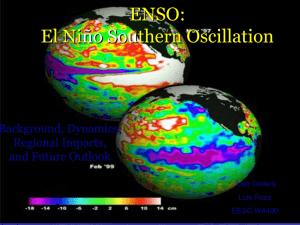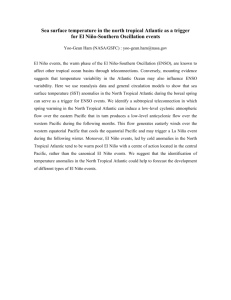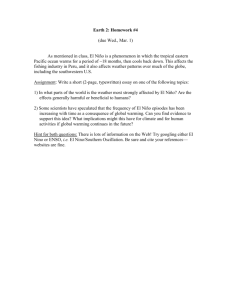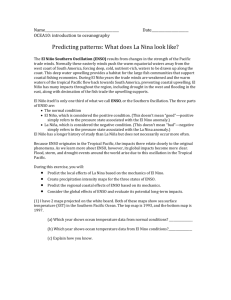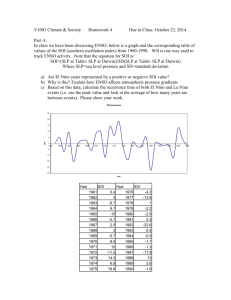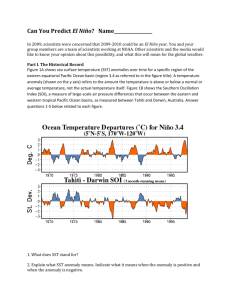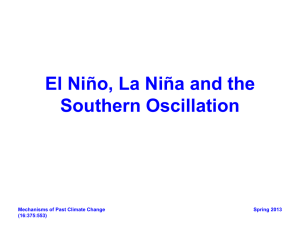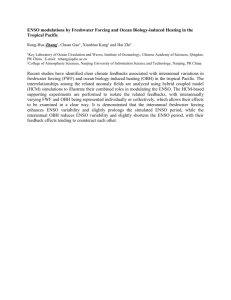12_CM_AgriculturalConsequencesofENSO
advertisement
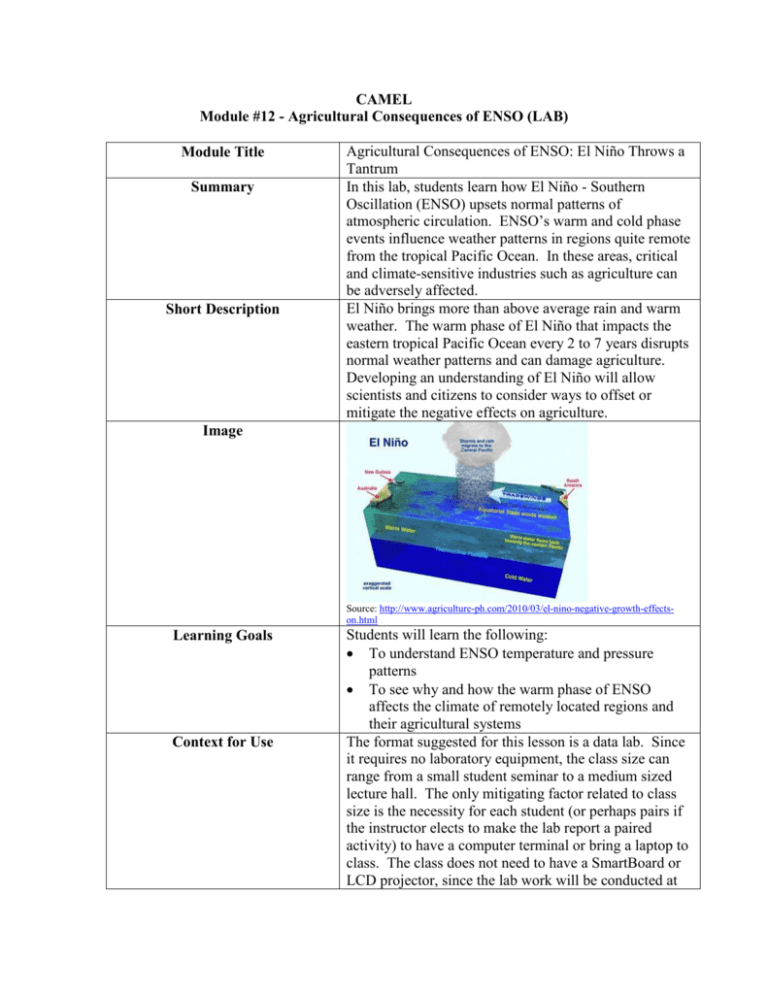
CAMEL Module #12 - Agricultural Consequences of ENSO (LAB) Module Title Summary Short Description Agricultural Consequences of ENSO: El Niño Throws a Tantrum In this lab, students learn how El Niño - Southern Oscillation (ENSO) upsets normal patterns of atmospheric circulation. ENSO’s warm and cold phase events influence weather patterns in regions quite remote from the tropical Pacific Ocean. In these areas, critical and climate-sensitive industries such as agriculture can be adversely affected. El Niño brings more than above average rain and warm weather. The warm phase of El Niño that impacts the eastern tropical Pacific Ocean every 2 to 7 years disrupts normal weather patterns and can damage agriculture. Developing an understanding of El Niño will allow scientists and citizens to consider ways to offset or mitigate the negative effects on agriculture. Image Source: http://www.agriculture-ph.com/2010/03/el-nino-negative-growth-effectson.html Learning Goals Context for Use Students will learn the following: To understand ENSO temperature and pressure patterns To see why and how the warm phase of ENSO affects the climate of remotely located regions and their agricultural systems The format suggested for this lesson is a data lab. Since it requires no laboratory equipment, the class size can range from a small student seminar to a medium sized lecture hall. The only mitigating factor related to class size is the necessity for each student (or perhaps pairs if the instructor elects to make the lab report a paired activity) to have a computer terminal or bring a laptop to class. The class does not need to have a SmartBoard or LCD projector, since the lab work will be conducted at Description and Teaching Materials individual computers, but access to multimedia equipment is preferred. See “Description and Teaching Materials” below for link to the source lab. Description and Teaching Materials: The structure and primary components of this lab lesson is sourced from Columbia University’s Earth Environmental Systems Climate (EESC) course Lab #6 Agricultural Consequences of ENSO (Spring 2011). I. ENSO: Sea surface temperature behavior A. Background Large amounts of heat can be exchanged between the ocean and atmosphere, providing a link between these two major components of the climate system. In this lab, we will look at “sea surface temperature anomalies” (SST). Anomalies are the difference between the SST measured that month (e.g. September of 1997) and the averaged SST for all Septembers for which we have data; our data spans January 1970-September 1998. The horizontal (x and y direction) coverage is 124E to 70W longitude and 29S to 29N latitude, with a resolution of 2C. To learn more about these data, visit the documentation page. B. Temperature maps Use the viewer (if that doesn't work, try the alternate link) to look at an animation of monthly SST anomalies. Take note of the latitudinal and longitudinal range of the map view here. To animate, go to the white box above the SST anomaly map and type in "Jan 1970 to Sep 1998" and click on the redraw button to the left. You will see a progression of SST anomaly maps drawn, starting from January 1970 and continuing to the present. Find the largest spatial-scale anomaly patterns that you see, then hit "Stop" on your internet browser to stop the animation. Task 1: Describe the pattern of SST anomalies across the tropical Pacific. Use these questions to guide descriptions (2-3 sentences): Where are the anomalies the largest? What is the typical temperature range of the anomalies? II. The Effect of ENSO on the Tropical Atmosphere During warm phase of ENSO, the atmosphere in the tropics is heated via increased SST, so the atmosphere must redistribute the extra heat. It does so by increasing convection. One way we can observe changes in convection is via satellite observations of the outgoing longwave radiation (OLR). The OLR measurement tells us the temperature of the surface that the satellite sees. If the atmosphere between the satellite and the Earth's surface is clear, then the satellite essentially sees the OLR from the ocean or land surface. However, if the atmosphere is full of thick clouds, then the satellite sees the top of the. Since the cloud tops may be 5-10 km above the surface, they are much colder than the surface. Therefore, when we see patches of low OLR, we interpret this as the locations of thick thunderclouds. Task 2: Now look at the OLR anomaly for December 1982 -February 1983, which is the middle of a strong ENSO warm phase event (this is the same period for which you just examined sea surface temperature data). Where are the most negative OLR anomalies found? What could you infer from this about cloud behavior during a warm phase event (El Niño) compared to normal conditions? Where are the most negative OLR anomalies found? What could you infer from this about cloud behavior during a warm phase event (El Niño) compared to normal conditions? III. What is the relationship between SST and sealevel pressure in the tropical Pacific? This question will be investigated by examining the correlation between sea-surface temperatures and pressures, using the datasets described below: NINO3 (TEMPERATURE) is the average SST anomaly over the region 150W to 90W, 5N to 5S. (From the map views of SST anomaly, you can see that this region has the strongest SST anomalies associated with ENSO warm phase events). The NINO3 data (click for documentation) were computed by Alexey Kaplan at LDEO from the Global Ocean Surface Temperature Atlas SST anomaly dataset. SOI (PRESSURE) is the difference between the atmospheric sea level pressure anomaly at Tahiti (in the southeastern tropical Pacific), and the atmospheric sea level pressure anomaly at Darwin, Australia (in the western Pacific). Pressure is usually low in the western tropical Pacific, and high in the eastern tropical Pacific (given the pattern of sea surface temperatures across the tropical Pacific, does this make sense?). The SOI tells us when this atmospheric pressure pattern departs from normal conditions, or in other words, when atmospheric sea level pressure is simultaneously lower in the eastern tropical Pacific, and higher in the western tropical Pacific, or vice versa. The SOI data are from the Australian Bureau of Meteorology. We will use the data for the period 1961 through 1990. Save the data (accompanying file) in a place you can easily access (e.g. the desktop). There are three columns of data. The first is the calendar year. The second column is the NINO3 averaged SST anomaly for Sep, Oct, Nov of the corresponding years, and the third column gives like averages of the SOI (Jun-Nov). These intervals of months correspond to the seasons when the maximums of SST and SOI occur during most El Niño and La Niña episodes. Task 3: Make a scatter plot of NINO3 vs. SOI. Compute the correlation between SOI and NINO3 using Excel's =correl() function and report it on your plot. IV. Relationships between SOI, precipitation, river discharge, and agricultural yields The atmosphere has to get rid of the extra heating supplied by the eastern tropical Pacific Ocean during an ENSO warm phase event. It does this in certain preferred patterns, which affect temperatures and precipitation in many places around the world. As a result, weather-sensitive human activities, such as agriculture, can be affected. In this part of the lab, we'll examine how closely ENSO parameters are associated with remotely located agricultural yields. We'll do so by examining the correlation between SOI and selected wheat yields from agricultural model time series in Australia. View a map of Australia obtained from the National Mapping Division of Geoscience Australia to learn more about the various regions you'll be examining in today's lab. Most of Australia is semi-arid, and climate conditions are relatively unfavorable for many agricultural crops. Of the major grains, wheat requires the least amount of precipitation to grow, and thus is the most important grain crop in the country. Australia is one of only about five or six countries that produce a significant excess of wheat crop beyond domestic consumption requirements. These few countries supply most of the grain for international trade in wheat. Since ENSO is responsible for a significant portion of the interannual climate variability in parts of Australia, knowledge of ENSO conditions is critical in agricultural decisions in many regions of the country. Task 4: What is the relationship between SOI and annual precipitation in Australia? Using SOI as an indicator of ENSO conditions, make a scatter plot of annual precipitation amount in the catchment of the River Murray (southeastern Australia) vs. SOI (Table 2). The Murray River catchment basin (map obtained from the Murray-Darling Basin Commission) precipitation and discharge data were obtained via personal communications with staff of the Australian Bureau of Meteorology and the MurrayDarling Basin Commission, respectively. Add a linear regression slope, with correlation coefficient and slope equation to the plot. Is there higher rainfall during El Niño or La Niña episodes? Task 5: What are the connections between SOI and Wheat Yields? Make scatter plots of Wheat Yields in NSW, Queensland (QLD), and Western Australia (WA) each vs. SOI (Table 3) – i.e., you should get three different series. Do the years of higher and lower yield tend to occur in El Niño or La Niña episodes? Add a linear regression slope, with correlation coefficient and slope equation on each plot (or each series, if you put them all on the same plot). Which regions’ wheat yields are positively correlated with SOI? DISCUSSION: Based on your observations … What physical processes link SST and SSP? Explain the NINO3 and SOI correlation. (paragraph) Which ENSO state is likely to be more favorable for growing wheat in Australia? (in other words, do you think droughts would be more likely during El Niño or La Niña episodes?). Why? (paragraph) Below are the links for source material and resources: EESC course page, Agricultural Consequences of ENSO lab: https://courseworks.columbia.edu/cms/ Handouts and Directions: Lab instructions Data Background Information for instructors/TAs: Instructors/TAs may find it useful to refer to lecture notes from the following two lectures: ENSO Impacts; Other Climate Variations/Oscillations: NAO, NAM, SAM, PDO (Ting) Teaching Tips and Notes Assessment References and Resources Equipment/Supplies: Computer lab or moveable laptops with Internet access and Excel. LCD projector or SmartBoard See background information for instructors/TAs. Students summarize their findings in a lab report. All resources cited in the description of the course.
